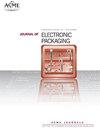Performance Analysis of Corrosion Resistant Electroless Nickel-Plated Impinging CNC Manufactured Liquid Cooling Cold Plate
IF 2.3
4区 工程技术
Q3 ENGINEERING, ELECTRICAL & ELECTRONIC
引用次数: 0
Abstract
More than ever before, data centers must deploy robust thermal solutions to adequately host the high-density and high-performance computing that is in high demand. The newer generation of central processing units (CPUs) and graphics processing units (GPUs) has substantially higher thermal power densities than previous generations. In recent years, more data centers rely on liquid cooling for the high-heat processors inside the servers and air cooling for the remaining low-heat Information Technology Equipment (ITE). This hybrid cooling approach creates a smaller and more efficient data center. The deployment of direct-to-chip cold plate liquid cooling is one of mainstream approaches to providing concentrated cooling to targeted processors. In the current study, a processor level experimental setup was developed to evaluate the cooling performance of a novel Computer Numerical Control (CNC) machined nickel-plated impinging cold plate on a 1 in x 1 in mock heater that represents a functional processing unit. The pressure drop and thermal resistance performance curves of the electroless nickel-plated cold plate are compared to those of a pure copper cold plate. A temperature uniformity analysis is done using CFD and compared to the actual test data. Lastly, the CNC machined pure copper one is compared to other reported cold plates to demonstrate its superiority of the design with respect to the cooling performance.耐腐蚀化学镀镍冲击数控制造液冷冷板的性能分析
数据中心比以往任何时候都更需要部署强大的热解决方案,以充分承载高密度和高性能的计算需求。新一代的中央处理单元(CPU)和图形处理单元(GPU)具有比前几代高得多的热功率密度。近年来,越来越多的数据中心对服务器内的高温处理器采用液体冷却,对剩余的低热信息技术设备(ITE)采用空气冷却。这种混合冷却方法创建了一个更小、更高效的数据中心。直接到芯片冷板液体冷却的部署是为目标处理器提供集中冷却的主流方法之一。在当前的研究中,开发了一个处理器级实验装置,以评估新型计算机数控(CNC)加工的镀镍冲击冷板在1英寸x 1英寸模拟加热器上的冷却性能,该加热器代表一个功能处理单元。将化学镀镍冷板与纯铜冷板的压降和热阻性能曲线进行了比较。使用CFD进行温度均匀性分析,并与实际测试数据进行比较。最后,将数控加工的纯铜冷板与其他报道的冷板进行了比较,以证明其在冷却性能方面的设计优势。
本文章由计算机程序翻译,如有差异,请以英文原文为准。
求助全文
约1分钟内获得全文
求助全文
来源期刊

Journal of Electronic Packaging
工程技术-工程:电子与电气
CiteScore
4.90
自引率
6.20%
发文量
44
审稿时长
3 months
期刊介绍:
The Journal of Electronic Packaging publishes papers that use experimental and theoretical (analytical and computer-aided) methods, approaches, and techniques to address and solve various mechanical, materials, and reliability problems encountered in the analysis, design, manufacturing, testing, and operation of electronic and photonics components, devices, and systems.
Scope: Microsystems packaging; Systems integration; Flexible electronics; Materials with nano structures and in general small scale systems.
 求助内容:
求助内容: 应助结果提醒方式:
应助结果提醒方式:


